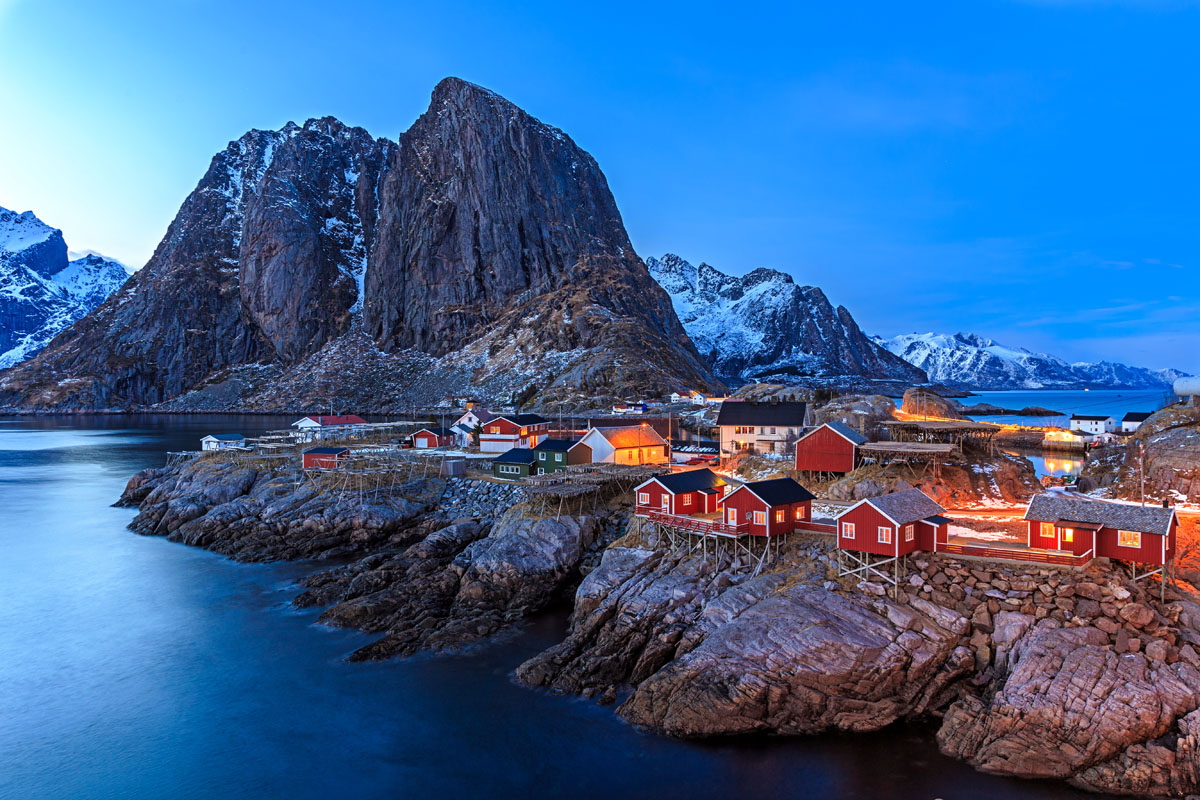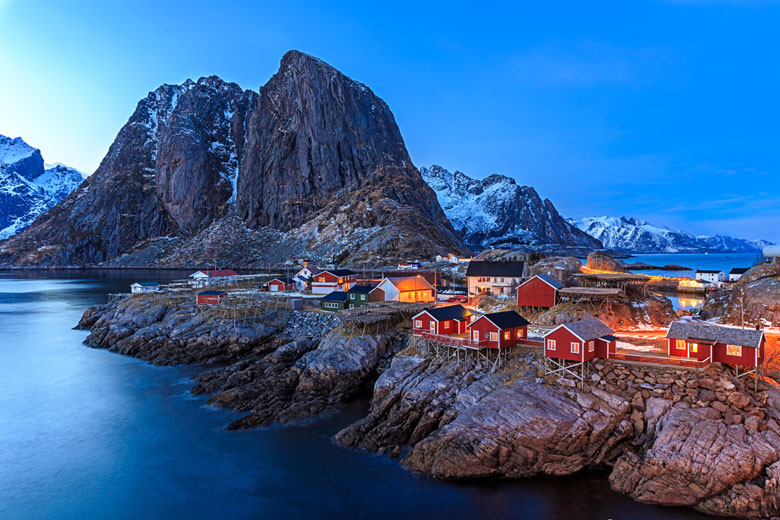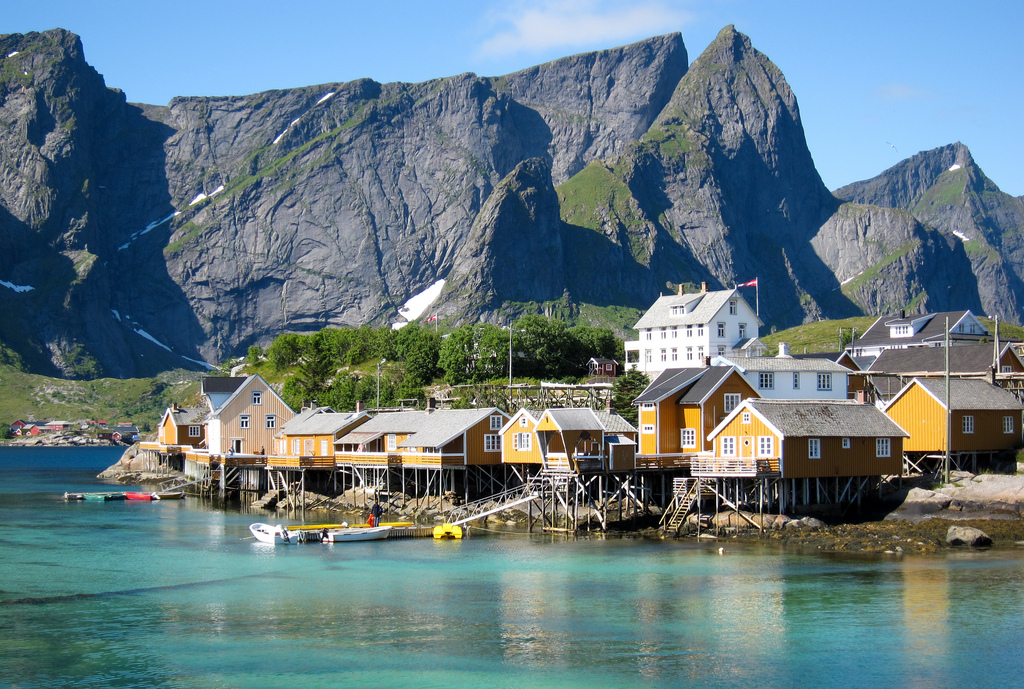



The brightly colored seaside wooden huts of the Lofoten Islands (rorbuer plural, or rorbu singular) are steeped in tradition, once housing scores of hardened fishermen who made the winter pilgrimage to the world’s most fertile cod fishing grounds. Fish are still the basis of all human settlement on Lofoten, but beginning in the 1960’s a number of the huts have been converted into accommodation for travelers. Visiting the Lofoten Islands and staying in a rorbu makes an already extraordinary experience even more distinctive.
Rorbuer, like all accommodations in Norway, can be pricey. Many rorbu have multiple bedrooms and can fit four or more people. For each group of cabins there is a noticeable price difference between the cheapest and most expensive options. Rorbuer generally are outfitted with full kitchens giving you the option to cook. Prices below are for the 2013 summer high season and include VAT.
Editor’s Choice: Reine Rorbuer (Reine)
Reine is the most scenic fishing village on the Lofoten Islands and the Reine Rorbuer are best in class. On the website, you can click on the ‘Rorbu Cabins” link for a map of the grounds and photos of each cabin. Some cabins are not available as they are privately owned, but you really can’t wrong with any of the remaining options. We stayed at #21 Gro our visit to Reine, which has some of the biggest views. 2016 summer prices: from 1645K per night.
Reine Sleeper: Sakrisøy Rorbuer (Reine)
Sakrisøy is a tiny island just outside the village of Reine, and it’s tough to top the setting of the Sakrisøy Rorbuer. In addition to stunning surroundings and cabins that have been restored with great care, the owners operate a unique porcelain doll museum and antique shop on site. Rorbuer aren’t cheap in general, but the Sakrisøy rorbuer are a good value and include the free use of a rowboat. 2016 summer prices: from 1395K per night.

Location, location, location: Rorbu Cabins at Valen (Reine)
These two exceptional rorbuer, Valbua and Aronbua, sit side-by-side on their own stretch of water. Their only shortcoming is proximity to the main road through Reine, which runs behind the cabins. However, we’ve received word that traffic is light even in the peak season, and the few cars that pass slow down considerably to cross the nearby bridge, making them a non-issue. The renovations to these rorbuer are fantastic, they ample exterior space, and are centrally located 100 meters from the market. 2016 summer prices: from 1600K per night. 10% discount for one-week rentals.
The ‘New’ Guy: Eliassen Rorbuer (Hamnøy)
The site may be old but the rorbuer were renovated in 2010 (the term ‘gutted’ is more accurate). The rustic charm is gone but the cabins are clean, slightly cheaper than the nearby counterparts, and have superb views. The Eliassen Rorbuer are located in Hamnøy just down the road from Reine, and also offer modest hostel rooms for 450K. 2016 summer prices: from 990K per night.
Svolvær’s Finest: Svinøya Rorbuer (Svolvær)
The Svinøya Rorbuer are several well-regarded cabins situated on a small island in the Svolvær harbor, a short walk to the town center. The offerings include original rorbuer that have been thoughtfully restored as well as some cabins newly built in the traditional style. The downside is that they are located in Svolvær, which is beautiful but less desirable than nearby Henningsvær or Reine. The cabins also are very expensive compared to the competition on other islands. 2016 summer prices: from 1375K per night.
Caveat Emptor (Buyer Beware): Henningsvær Rorbuer
Everybody loves Henningsvær, but not the Henningsvær Rorbuer, and in particular the management. Avoid the headache and make the most of your stay in this superb fishing village by considering these Henningsvær alternatives:
Henningsvaer Bryggehotell
This hotel is nice and well located but pricey. Some rooms don’t have much of a view but the restaurant looks out over the water. You can easily walk the Henningsvær Harbor right from the hotel. Rooms from 1500K per night.
Nord Norsk Klatreskole (North Norwegian School of Mountaineering)
For adventure seekers and those on a budget, the Climber’s Café at Nord Norsk Klatreskole is a great option. Accommodations are cheap and fun with a hostel-like atmosphere, and you can organize many of the your climbing and skiing excursions on site. At the least, you can stop by for beer and conversation. Beds from 300K, rooms from 500K per night.
Gammelfielten Brygge
If you are planing on staying in Henningvaer for a few days, give the Gammelfileten Brygge a serious look. These four outstanding apartments located in the Henningsvær Harbor are a great deal for Norway. A three-night stay is required during the peak season. From 1100K per night.
Condition: The rorbuer themselves vary significantly. Some remain rustic, with most of the original wood, while others have been fully restored or newly constructed. Even the shabbiest rorbuer now include comforts that the fishermen never dreamed of (not to mention that they sleep a fraction of the people they once did).
Location: The westernmost Lofoten Islands have always been home to the majority of the fishing activity—this is where you will find most of the genuine rorbuer. A number of lookalikes have popped up closer to the mainland around Svolvær, for example, that are not as enjoyable as the real thing.
Cost: Rorbuer are expensive, like most accommodations in Norway, but for each group of rorbuer there is a noticeable price difference between the cheapest and most expensive cabins. The cheaper cabins aren't as fancy but are closest to the real thing and loaded with character. Also, rorbuer also are outfitted with full kitchens and allow you the option to buy groceries and cook as you wish. Prices are at least 25% lower outside of the summer high season.
The Lofoten fishery is a gold rush of sorts. Around 900 AD, tales starting spread along the Norwegian coast of the bounteous winter fishery off the Lofoten Islands, and people rowed and sailed the long journey north. In the early 1100’s, King Øistein mandated that the first rorbuer be built on the Lofoten Islands to house the influx of visiting fishermen. The cabins kept increasing in numbers and operated at capacity for centuries, but by the mid-1900’s fishing boats had modernized and some fishermen were choosing to sleep on their vessels.
Around 1960, a number of empty rorbuer were first rented out to tourists, and many rorbuer have undergone varying degrees of restoration since. While these cabins are no longer the fishermen’s preferred domiciles, the Lofoten Islands remain one of the world’s great fisheries, primarily from January through April when the cod return to the area to spawn.